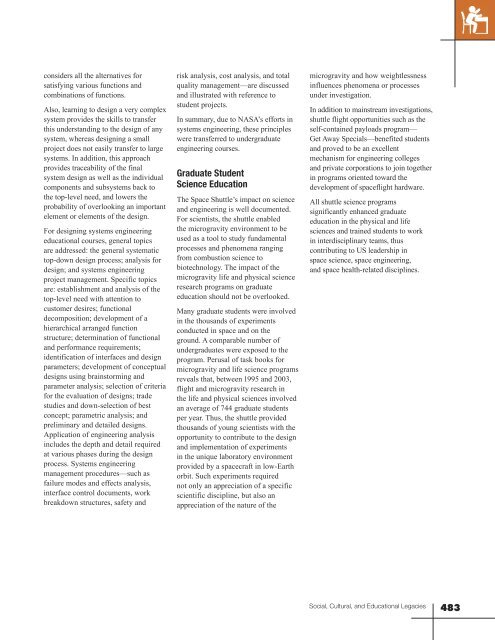Social, Cultural and Educational Legacies - ER - NASA
Social, Cultural and Educational Legacies - ER - NASA
Social, Cultural and Educational Legacies - ER - NASA
Create successful ePaper yourself
Turn your PDF publications into a flip-book with our unique Google optimized e-Paper software.
considers all the alternatives forsatisfying various functions <strong>and</strong>combinations of functions.Also, learning to design a very complexsystem provides the skills to transferthis underst<strong>and</strong>ing to the design of anysystem, whereas designing a smallproject does not easily transfer to largesystems. In addition, this approachprovides traceability of the finalsystem design as well as the individualcomponents <strong>and</strong> subsystems back tothe top-level need, <strong>and</strong> lowers theprobability of overlooking an importantelement or elements of the design.For designing systems engineeringeducational courses, general topicsare addressed: the general systematictop-down design process; analysis fordesign; <strong>and</strong> systems engineeringproject management. Specific topicsare: establishment <strong>and</strong> analysis of thetop-level need with attention tocustomer desires; functionaldecomposition; development of ahierarchical arranged functionstructure; determination of functional<strong>and</strong> performance requirements;identification of interfaces <strong>and</strong> designparameters; development of conceptualdesigns using brainstorming <strong>and</strong>parameter analysis; selection of criteriafor the evaluation of designs; tradestudies <strong>and</strong> down-selection of bestconcept; parametric analysis; <strong>and</strong>preliminary <strong>and</strong> detailed designs.Application of engineering analysisincludes the depth <strong>and</strong> detail requiredat various phases during the designprocess. Systems engineeringmanagement procedures—such asfailure modes <strong>and</strong> effects analysis,interface control documents, workbreakdown structures, safety <strong>and</strong>risk analysis, cost analysis, <strong>and</strong> totalquality management—are discussed<strong>and</strong> illustrated with reference tostudent projects.In summary, due to <strong>NASA</strong>’s efforts insystems engineering, these principleswere transferred to undergraduateengineering courses.Graduate StudentScience EducationThe Space Shuttle’s impact on science<strong>and</strong> engineering is well documented.For scientists, the shuttle enabledthe microgravity environment to beused as a tool to study fundamentalprocesses <strong>and</strong> phenomena rangingfrom combustion science tobiotechnology. The impact of themicrogravity life <strong>and</strong> physical scienceresearch programs on graduateeducation should not be overlooked.Many graduate students were involvedin the thous<strong>and</strong>s of experimentsconducted in space <strong>and</strong> on theground. A comparable number ofundergraduates were exposed to theprogram. Perusal of task books formicrogravity <strong>and</strong> life science programsreveals that, between 1995 <strong>and</strong> 2003,flight <strong>and</strong> microgravity research inthe life <strong>and</strong> physical sciences involvedan average of 744 graduate studentsper year. Thus, the shuttle providedthous<strong>and</strong>s of young scientists with theopportunity to contribute to the design<strong>and</strong> implementation of experimentsin the unique laboratory environmentprovided by a spacecraft in low-Earthorbit. Such experiments requirednot only an appreciation of a specificscientific discipline, but also anappreciation of the nature of themicrogravity <strong>and</strong> how weightlessnessinfluences phenomena or processesunder investigation.In addition to mainstream investigations,shuttle flight opportunities such as theself-contained payloads program—Get Away Specials—benefited students<strong>and</strong> proved to be an excellentmechanism for engineering colleges<strong>and</strong> private corporations to join togetherin programs oriented toward thedevelopment of spaceflight hardware.All shuttle science programssignificantly enhanced graduateeducation in the physical <strong>and</strong> lifesciences <strong>and</strong> trained students to workin interdisciplinary teams, thuscontributing to US leadership inspace science, space engineering,<strong>and</strong> space health-related disciplines.<strong>Social</strong>, <strong>Cultural</strong>, <strong>and</strong> <strong>Educational</strong> <strong>Legacies</strong>483
















